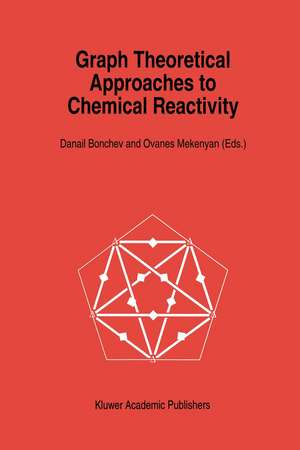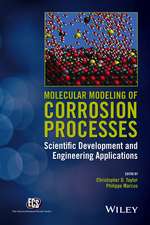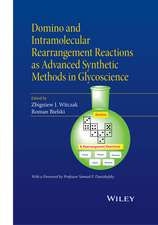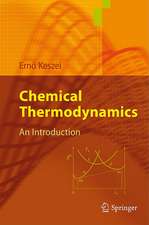Graph Theoretical Approaches to Chemical Reactivity: Understanding Chemical Reactivity, cartea 9
Editat de Danail D. Bonchev, O.G. Mekenyanen Limba Engleză Paperback – 11 oct 2012
| Toate formatele și edițiile | Preț | Express |
|---|---|---|
| Paperback (1) | 944.67 lei 6-8 săpt. | |
| SPRINGER NETHERLANDS – 11 oct 2012 | 944.67 lei 6-8 săpt. | |
| Hardback (1) | 950.66 lei 6-8 săpt. | |
| SPRINGER NETHERLANDS – 30 iun 1994 | 950.66 lei 6-8 săpt. |
Din seria Understanding Chemical Reactivity
- 18%
 Preț: 1221.51 lei
Preț: 1221.51 lei - 18%
 Preț: 1240.16 lei
Preț: 1240.16 lei - 15%
 Preț: 638.76 lei
Preț: 638.76 lei - 24%
 Preț: 798.19 lei
Preț: 798.19 lei - 18%
 Preț: 734.44 lei
Preț: 734.44 lei - 18%
 Preț: 952.40 lei
Preț: 952.40 lei -
 Preț: 391.40 lei
Preț: 391.40 lei - 18%
 Preț: 951.29 lei
Preț: 951.29 lei - 18%
 Preț: 1227.67 lei
Preț: 1227.67 lei -
 Preț: 386.22 lei
Preț: 386.22 lei - 15%
 Preț: 645.79 lei
Preț: 645.79 lei - 18%
 Preț: 1832.08 lei
Preț: 1832.08 lei - 18%
 Preț: 901.11 lei
Preț: 901.11 lei - 18%
 Preț: 946.87 lei
Preț: 946.87 lei - 15%
 Preț: 577.22 lei
Preț: 577.22 lei - 15%
 Preț: 635.47 lei
Preț: 635.47 lei - 18%
 Preț: 1229.91 lei
Preț: 1229.91 lei -
 Preț: 390.63 lei
Preț: 390.63 lei - 18%
 Preț: 1849.41 lei
Preț: 1849.41 lei - 15%
 Preț: 595.86 lei
Preț: 595.86 lei - 18%
 Preț: 951.29 lei
Preț: 951.29 lei - 18%
 Preț: 954.93 lei
Preț: 954.93 lei - 18%
 Preț: 1227.84 lei
Preț: 1227.84 lei - 18%
 Preț: 1835.53 lei
Preț: 1835.53 lei - 18%
 Preț: 950.66 lei
Preț: 950.66 lei
Preț: 944.67 lei
Preț vechi: 1152.04 lei
-18% Nou
Puncte Express: 1417
Preț estimativ în valută:
180.78€ • 187.59$ • 151.10£
180.78€ • 187.59$ • 151.10£
Carte tipărită la comandă
Livrare economică 18 martie-01 aprilie
Preluare comenzi: 021 569.72.76
Specificații
ISBN-13: 9789401045261
ISBN-10: 9401045267
Pagini: 300
Ilustrații: XI, 283 p.
Dimensiuni: 160 x 240 x 16 mm
Greutate: 0.42 kg
Ediția:Softcover reprint of the original 1st ed. 1994
Editura: SPRINGER NETHERLANDS
Colecția Springer
Seria Understanding Chemical Reactivity
Locul publicării:Dordrecht, Netherlands
ISBN-10: 9401045267
Pagini: 300
Ilustrații: XI, 283 p.
Dimensiuni: 160 x 240 x 16 mm
Greutate: 0.42 kg
Ediția:Softcover reprint of the original 1st ed. 1994
Editura: SPRINGER NETHERLANDS
Colecția Springer
Seria Understanding Chemical Reactivity
Locul publicării:Dordrecht, Netherlands
Public țintă
ResearchCuprins
1. Introduction to Graph Theory.- 1. Chemical Graph Theory.- 2. Representation and Characterization of a Graph.- 3. Realization of a Graph.- 4. Operations on Graphs.- 5. References.- 2. The Interplay Between Graph Theory and Molecular Orbital Theory.- 1. Introduction.- 2. Fundamentals of Graph Theory.- 3. Isomorphism of Graph Spectral Theory and Hückel Molecular Orbital Theory.- 4. Hückel Spectrum.- 5. Topological Effect on Molecular Orbitals.- 6. The HOMO-LUMO Separation.- 7. Topological Charge Stabilization.- 8. Localization Energy.- 9. Concluding Remarks.- 10. References.- 3. Topological Control of Molecular Orbital Theory:A Comparison of µ2-Scaled HüCkel Theory and Restricted Hartree-Fock Theory for Boranes and Carboranes.- 1. Introduction.- 2. Calculational Method.- 3. The Method of Moments.- 4. Elemental Boron.- 5. BnHn2-Clusters.- 6. The ?-Parameter of B10H102-.- 7. Reaction Pathways.- 8. Conclusion.- 9. References.- 4. Polyhedral Dynamics.- 1. Introduction.- 2. The Topology of Polyhedra.- 3. Polyhedral Isomerizations.- 4. Microscopic Models: Diamond-Square-Diamond Processes and Gale Diagrams.- 5. Macroscopic Models: Topological Representations.- 6. Literature References.- 5. Reaction Graphs.- 1. Introduction.- 2. Reaction Graphs of Rearrangements Via Carbocations.- 3. Automerization of Bulvalene, Other Valence Isomers of Annulenes,and Azabullvalene.- 4. Rotation in Molecular Propellers.- 5. Reaction Graphs for Rearrangements of Metallic Complexes.- 6. Xenon Hexafluoride.- 7. Heptaphosphide Trianion.- 8. Kinetic Graphs, Synthon Graphs, and Graph Transforms.- 9. Conclusions.- 10. References.- 6. Discrete Representations of Three-Dimensional Molecular Bodies and Their Shape Changes in Chemical Reactions.- 1. Introduction and Review of Basic TopologicalConcepts of Molecular Shape Representation.- 2. Molecular Shape Representation by Nuclear Potential Contours(NUPCO’s).- 3. Topological Patterns of NUPCO Sequences.- 4. Shape Changes of NUPCO Sequences Along Reaction Paths and in Conformational Domains.- 5. Shape Changes of NUPCO’s in Conformational Changes and inMolecular Deformations; NUPCO Shape Invariance Domains of the Configuration Space.- 6. Local Shape Invariance of NUPCO’s and the Transfer of FunctionalGroups in Chemical Reactions.- 7. Summary.- 8. References.- 7. The Invariance of Molecular Topology in Chemical Reactions.- 1. Introduction.- 2. From a Lewis Diagram to the Pseudo-Graph and Graphoid.- 3. From Graph (Graphoid) to Surface.- 4. What Is the Topological Homeomorphism from the Chemical Pointof View?.- 5. The Invariance of the Euler Characteristic in Chemical Reactions.- 6. The Main Theorem.- 7. Conclusion.- 8. References and Notes.- 8. Topological Indices and Chemical Reactivity.- 1. Introduction.- 2. Basic Principles Underlying the Topological Nature of Chemical Reactivity.- 3. Molecular Topology and Topological Invariants.- 4. Applications of Topological Indices to Chemical Reactivity.- 5. Conclusions.- 6. References.- 9. Graph-Theoretical Models of Complex Reaction Mechanisms and Their Elementary Steps.- 1. Introduction.- 2. Graph-Theoretical Approach to Studies in the Elementary Stepsof Complex Reactions.- 3. Classification and Coding of Linear Reaction Mechanisms By UsingKinetic Graphs.- 4. Application of Bipartite Graphs and Stoichiometric Matrices to theDescription of Linear and Nonlinear Reaction Mechanisms.- 5. Topological Aspects of Complex Reaction Mechanisms.- 6. References.








